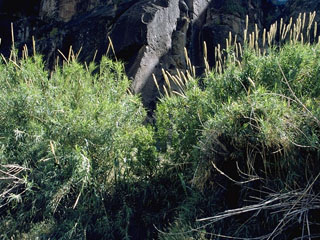Arundo: Donax, do Tell
Thursday, May 3rd, 2018This is Passport to Texas
A tall, non-native invasive grass, Arundo donax grows along creek and river beds and spreads quickly. It impairs native ecology, destabilizes and impedes bank access and increases flood and fire risks.
We’re really seeing that the source of this plant getting into our waterways seems to be construction activities, fill dirt placement, and mowing that pulls it down into our creeks.
Monica McGarrity is aquatic invasive species team leader for Texas Parks and Wildlife. Angela England also works on this team as a biologist. She says the agency’s launched a new Arundo awareness and prevention campaign developed in partnership with the Nueces River Authority, Texas A&M AgriLife Extension and the Texas Department of Transportation.
[In] this new program, we’ve geared a lot of the materials to folks in the construction industry and vegetation management. So, mowers, and folks running dozers, and so forth.
England says prevention and management begins with knowing the enemy.
We want everybody that’s in these industries to have a feel for what the plant is. We’ve got a training video; we’ve got materials that we can get to you on how to identify it. We want you to sound the alarm if you see it—and let your boss know: “Hey, it looks like there’s fragments of this bad stuff in the fill dirt that we just got. Maybe we should send it back.” And start hitting it before it gets into new places.
More on the Arundo donax campaign tomorrow.
The Wildlife Restoration program supports our series.
For Texas Parks and Wildlife, Cecilia Nasti.





 Passport to Texas is a
Passport to Texas is a  Passport to Texas is made available by:
Passport to Texas is made available by: